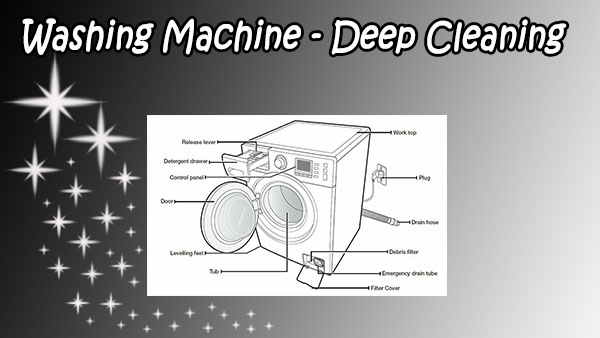
Washing Machine – Deep Cleaning
Yes, even our cleaning equipment needs a good wash every now and then! Especially so do our precious washing machines. You might be surprised to know how much mould and dirt can build up in our machines over the course of a few weeks or months.
There are various methods for giving your washing machine a good clean and a plethora of different products you can use. The most natural and environmentally friendly method will almost always be white vinegar and baking soda/bicarbonate of soda. However, when you’ve let things get a bit too out of control then you may want to try something stronger. Cue the chemicals! This is generally either bleach or antibacterial products.
- Bleach: Flash, domestos, etc. ranging from neat to diluted.
- Antibacterial: Dettol, Zoflora, Stardrops disinfectant, etc.
Here are some steps to help you give a thorough and comprehensive clean:
Step 1: The seal
Throw on some rubber gloves and give the seal around the door a thorough clean. You can’t use abrasive cleaning products on this part so I would recommend spraying on some vinegar (or washing up liquid) and leaving it to soak for at least half an hour. Then peel back the layers and scrub as much of the mould away as you can (a toothbrush helps get in the small front rim). Check this area for buttons or coins.
It’s definitely worth giving this a regular clean. If you leave it too long then any accumulated mould could penetrate the rubber seal, in effect staining the area. If this happens then the rubber could eventually be worn away.
Step 2: The detergent drawer
Most detergent dispenser drawers are removable (be gentle). To clean, either place in the top shelf of your dishwasher or rinse in hot soapy water.
- Natural method: Soak with vinegar or hot soapy water.
- Chemical method: Mould remover spray or a bleach soak. Or use Dettol wipes if preferred.
Check the insert area is clean before placing the drawer back in. You will notice what a difference this one step makes!
Step 3: The drum
 There are so many products you can use for cleaning your drum. The most gentle method would be to put a cup of vinegar into the drum before starting the empty wash cycle, or soda crystals. However, you can also use any type of disinfectant or multi purpose cleaner. Stardrops does a disinfectant and all round cleaner which you can squirt into the drum prior to running the wash cycle. Also worth mentioning here is to give the inner door a clean using hot water and your chosen cleaner.
There are so many products you can use for cleaning your drum. The most gentle method would be to put a cup of vinegar into the drum before starting the empty wash cycle, or soda crystals. However, you can also use any type of disinfectant or multi purpose cleaner. Stardrops does a disinfectant and all round cleaner which you can squirt into the drum prior to running the wash cycle. Also worth mentioning here is to give the inner door a clean using hot water and your chosen cleaner.
Step 4: Run a hot wash
- Natural method: Mix ¼ cup of baking soda (or bicarb) with ¼ cup of water. Add this solution to your machine’s detergent container. Pour 2 cups of white vinegar into the drum then run a hot wash. For an extra nice smell add 5-10 drops of lemon and/or tea tree essential oils.
- Chemical method: Add a cap full of bleach or antibac into all three compartments (detergent, rinse and conditioner). Pour a cup of antibacterial into the drum and then run a hot wash.
Step 5: Clean the Facia

To make your washing machine really sparkle you should give the Facia a clean too. Hot water with a kitchen spray, bleach, vinegar, or any disinfectant should work well. Once it is scrubbed give it a dry to really bring out the shine. Remember to wash the porthole door. If you can, remove the washing machine from under the kitchen counter and wash down the top and sides.
If you follow all these steps then you should have a perfectly clean and sparkling washing machine.
Try and run a hot wash at least once a month on the machine to give it a clean (just using white vinegar or disinfectant in an empty drum). Or if your machine has a self cleaning option then try and run it at least once a month.
Tips:
- Add white vinegar to any washes at 40 degrees or less to help kill germs.
- Most washing machines have a “pre-chamber” which catch any debris such as buttons or coins, follow your manufacturer’s instructions (a quick Google will show you how) to clean this chamber out. Remember to unplug the machine before you do this!
- Check the inlet hose at least once a year. If there are any cracks, it should be replaced immediately: during the wash cycles, water pressure is very strong and a cracked hose could easily split open.
- Always leave the porthole door ajar in order to prevent unpleasant odours (and mould) from forming.
- Check your machine’s manual for instructions on how to clean your machine. Some manufacturers discourage the use of de-scaling or products or cleansers in their machines. Doing so may invalidate your warranty.
- Scrub any dirty spots with the rough side of a sponge dipped in a solution of one part vinegar, one part water.